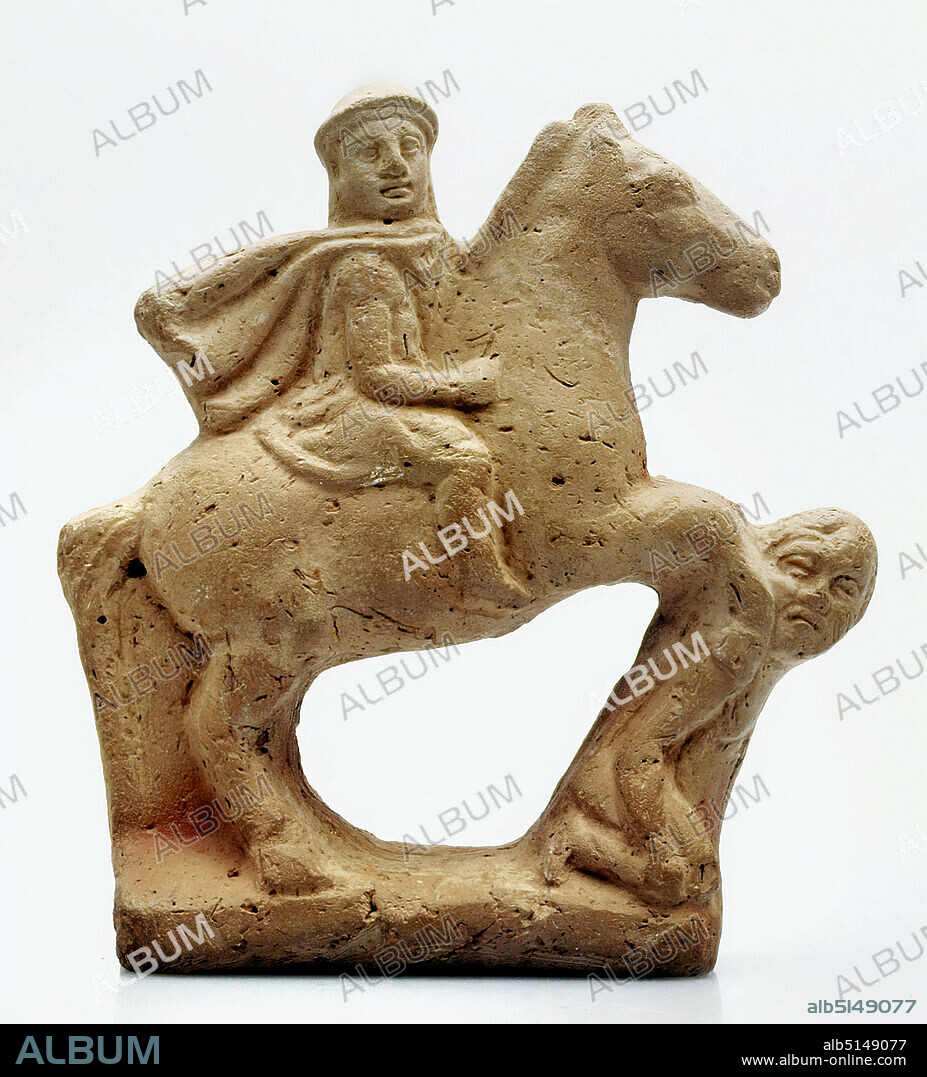alb5149077
Macedonian Horseman over an enemy, Clay, pressed into the mold, hand modeled, fired (pottery), Clay, Total: Height: 11.8 cm, Pottery, War, Riding (cavalry), Cavalry, Rider troops, Victory (armed conflict), Republican period, Early Imperial period, Middle Imperial period, On a flat base a rider gallops to the right. His horse has its front legs torn high into the air. Beneath it a man crouched on his knees. In the next moment the hooves seem to drum down on his shoulders and trample him completely to the ground. While the rider is dressed with a chiton, boots, a flat, beret-like headgear, the Macedonian causia, and a coat blowing backwards, which has been the Macedonian costume since Alexander the Great, his opponent is naked. His face shows asymmetrical features. The terracotta is probably based on a large-sculptural victory monument for Ptolemy I. Soter. The figure belongs to the group of the so-called Fayum terracottas. Alexandria, the international, Greek-influenced center of Egypt, is home to a multicultural society of Egyptians, Orientals, Greeks, Romans, Jews, and others, whose different religious ideas are gradually merging. Insights into this world of faith are provided by the so-called Fayum terracottas. They are part of the religious household, children's toys, knick-knacks, but also cult symbols, grave goods, pilgrimage images, votive offerings and magical objects for banishing evil forces. They can be found in houses, graves and sanctuaries.

|
Ajouter à une autre Lightbox |
|
Ajouter à une autre Lightbox |



Avez-vous déjà un compte? S'identifier
Vous n'avez pas de compte ? S'inscrire
Acheter cette image.
Sélectionnez l'usage:

Légende:
Voir la traduction automatique
Macedonian Horseman over an enemy, Clay, pressed into the mold, hand modeled, fired (pottery), Clay, Total: Height: 11.8 cm, Pottery, War, Riding (cavalry), Cavalry, Rider troops, Victory (armed conflict), Republican period, Early Imperial period, Middle Imperial period, On a flat base a rider gallops to the right. His horse has its front legs torn high into the air. Beneath it a man crouched on his knees. In the next moment the hooves seem to drum down on his shoulders and trample him completely to the ground. While the rider is dressed with a chiton, boots, a flat, beret-like headgear, the Macedonian causia, and a coat blowing backwards, which has been the Macedonian costume since Alexander the Great, his opponent is naked. His face shows asymmetrical features. The terracotta is probably based on a large-sculptural victory monument for Ptolemy I. Soter. The figure belongs to the group of the so-called Fayum terracottas. Alexandria, the international, Greek-influenced center of Egypt, is home to a multicultural society of Egyptians, Orientals, Greeks, Romans, Jews, and others, whose different religious ideas are gradually merging. Insights into this world of faith are provided by the so-called Fayum terracottas. They are part of the religious household, children's toys, knick-knacks, but also cult symbols, grave goods, pilgrimage images, votive offerings and magical objects for banishing evil forces. They can be found in houses, graves and sanctuaries.
Personnalités:
Crédit:
Album / quintlox
Autorisations:
Modèle: Non - Propriété: Non
Questions sur les droits?
Questions sur les droits?
Taille de l'image:
3910 x 4320 px | 48.3 MB
Taille d'impression:
33.1 x 36.6 cm | 13.0 x 14.4 in (300 dpi)
Mots clés:
ADVERSAIRE • AIR • ALEXANDRIE • ANIMAL: CHEVAL • ARGILE • BIBELOT • BIBELOTS • BOTTE • BOTTES • CERAMIQUE • CHEVAL • CHEVAUX • CONFIANCE • CORPS VISAGE • DECORATION • DECORATIONS • DÉNUDÉ • EGYPTE • ENNEMI • ÉPAULES • FACE • FOI • GRAOUPE • GROUPE • GUERRE • INTERNATIONAL • JUIF (ADJECTIF) • JUIF • JUIFS (NOM) • JUIFS • JUIVE • MAISON • MAISONS • MATERIAU CERAMIQUE • MATERIAU TERRE CUITE • MONDE • NU • NUS • ORNEMENT • ORNEMENTS • PARURE • POTERIE • RELIGIOSITE • TERRE CUITE, VAISSELLE • TUMBAS • VAISSELLE EN TERRE CUITE • VETEMENT: BOTTES • VISAGE • VISAGES
 Pinterest
Pinterest Twitter
Twitter Facebook
Facebook Copier le lien
Copier le lien Email
Email
